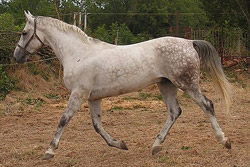
Image from Eventer
Gait basics are something every rider should know, whether you show Tennesee Walkers, race on the track or enjoy fox hunting.
Here is a quick look at some of the basics in the wonderful world of gaits.
The Foundation
Learn what a gait is and the two different types of gaits.
Gait
The repetitive patterns of limb movement used in locomotion. There are standard gaits that all horses share (i.e. walk, trot, etc.) as well as trained or bred gaits (including pacing, tolt, etc.)
Asymmetrical Gait
When movement of limbs on one side is not exactly repeated on the opposite side, such as when a horse canters or gallops.
Symmetrical Gait
When movement of limbs on one side is repeated on the opposite side half a stride later, such as when a horse trots or paces.
Gait Terminology
A collection of terms including different gaits and other related essentials for better understanding how a horse moves.
Canter
A fast 3-beat asymmetrical gait – Video Example
Collected
A controlled version of a gait, creating a slower and more powerful action.
Counter Canter
When an animal canters following the outside leg, rather than the inside leg.
Extension
The opposite of collection, this is an extension of a gait, creating a lengthened and more forward action.
Fox Trot
A short-step gait, similar to the transition from walk to trot – Video Example
Gallop
A very fast 4-beat symmetrical gait – Video Example
Hand Gallop
A faster, extended version of the canter – Video Example
Jog
The term for trot in Western riding, can also be used to describe a slow, short trotting gait in English – Video Example
Lope
Term for a slow canter in Western riding – Video Example
Pace
A fast 2-beat lateral symmetrical gait generally performed by gaited animals – Video Example
Paso Fino
The slowest 4-beat gait of the Paso Fino – Video Example
Paso Corto
The moderate 4-beat gait of the Paso Fino – Video Example
Paso Largo
The fastest 4-beat gait of the Paso Fino – Video Example
Rack
The fastest 4-beat gait characteristic of the American Saddlebred horses and a very flashy & smooth gait to ride. Example
Running Walk
Or amble is a 4-beat gait that is faster than a walk & characteristic of the Tennessee Walking Horse. Video Example
Slow Gait
A dramatically slow 4-beat gait characteristic of American Saddlebred horses. This is a rather difficult gait to sustain and not very comfortable to ride. Video Example
Trot
A moderate 2-beat diagonal symmetrical gait. – Video Example
Walk
A slow, 4-beat symmetrical gait. – Video Example
Stride Phases
The terms below refer to each stage of a horse stride, regardless of the gait.
Here is a Video Example of a horse trotting that beautifully illustrates the ideas.
Stance Phase
During this phase at least one foot is making contact with the ground.
Swing Phase
The phase in which a leg is lifted and brought forward.
Suspension Phase
The phase in which no hooves are in contact with the ground.
Overlap Time
The stride suspension phase relative to the stride stance phase.
Many Thanks
This is a post I’ve been kicking around for some time & wordpress spring cleaning is a great way to come up with new/old ideas. Thanks to Behind the Bit for posting her article about Lesser Known Gait Terms which is a great (& really interesting) post. I loved her idea of providing a video example so I’ve done the same thing here…hope you don’t mind Stacey. 🙂
The Icelandic horse has a gait called a Tolt,which is like a fast walk 🙂